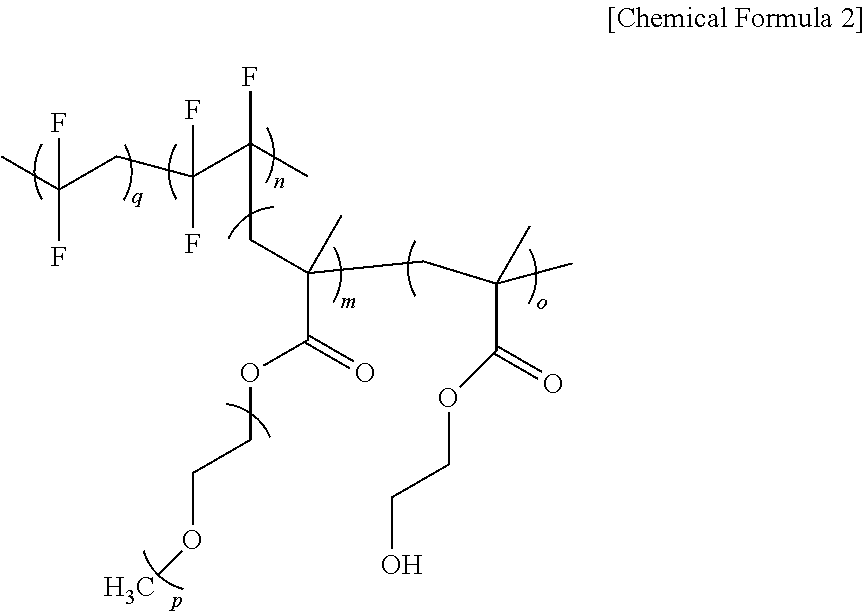Secondary battery solid electrolyte composition and solid electrolyte prepared therefrom
a solid electrolyte and secondary battery technology, applied in non-aqueous electrolytes, li-accumulators, electrochemical generators, etc., can solve the problems of limited chain fluidity complicated battery design, and limited electrochemical stability of peo polymer electrolyte, etc., to achieve high lithium ion dissociation, enhance ion conductivity and electrochemical stability of an electrolyte, and achieve electrochemical stability
- Summary
- Abstract
- Description
- Claims
- Application Information
AI Technical Summary
Benefits of technology
Problems solved by technology
Method used
Image
Examples
preparation example 2 preparation
of PVDF-co-(PCTFE-g-(PEGMA-co-HEMA) Graft Copolymerized Using ATRP Method (A2)
[0077]In a 1000 ml flask, 10 g of P(VDF-co-CTFE) having a weight average molecular weight (hereinafter, Mw) of 600,000 as a fluorine-based polymer, and 54 g of PEGMA and 1.5 g of HEMA as monomers to polymerize were introduced to 300 ml of an acetone solvent, and the result was stirred for 1 hour under a nitrogen condition.
[0078]After that, 0.002 g of CuCl2 as an ATRP reaction catalyst, 0.0051 g of TPMA as a ligand, and 0.231 g of Sn(EH)2 as an initiator were introduced to the flask, and an ATRP reaction was progressed by stirring the result for 30 hours under a nitrogen condition.
[0079]After completing the reaction, the produced polymer was immersed in an ether solvent 3 times to remove monomers that did not participate in the reaction. The finally obtained polymer was dried for 1 week under a vacuum condition to obtain a gel-type PVDF-co-(PCTFE-g-(PEGMA-co-HEMA) polymer.
example —
Example—Preparation of Solid Electrolyte
[0086]A solution obtained by dissolving 5 g of the polymer PVDF-co-(PCTFE-g-(PELMA-co-HEMA) prepared in each of Preparation Examples 1 and 2, trifunctional toluene diisocyanate as a multifunctional crosslinking agent and LiTFSI as a lithium salt while varying a content thereof as in the following Table 2 in 50 ml of a tetrahydrofuran (hereinafter, THF) solvent was stirred for 6 hours to prepare a homogeneous solution. The solution was casted on a Teflon plate with a size of 2 cm×2 cm, and the result was dried for 6 hours at room temperature in a dry room, and then heated for 1 hour at a temperature of 120° C. to progress a thermal curing reaction. After that, the solid film was removed from the Teflon plate using a knife to obtain a solid electrolyte for a secondary battery.
PUM
| Property | Measurement | Unit |
|---|---|---|
| thickness | aaaaa | aaaaa |
| ion conductivity | aaaaa | aaaaa |
| dielectric constant | aaaaa | aaaaa |
Abstract
Description
Claims
Application Information
 Login to View More
Login to View More - R&D
- Intellectual Property
- Life Sciences
- Materials
- Tech Scout
- Unparalleled Data Quality
- Higher Quality Content
- 60% Fewer Hallucinations
Browse by: Latest US Patents, China's latest patents, Technical Efficacy Thesaurus, Application Domain, Technology Topic, Popular Technical Reports.
© 2025 PatSnap. All rights reserved.Legal|Privacy policy|Modern Slavery Act Transparency Statement|Sitemap|About US| Contact US: help@patsnap.com



